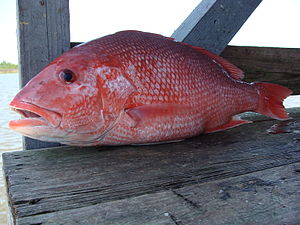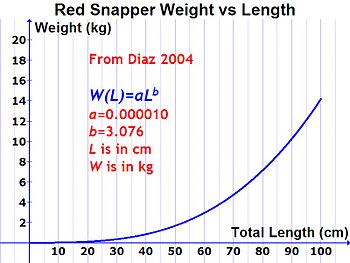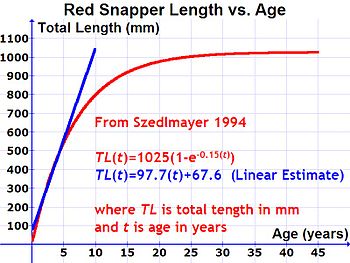- Red snapper (fish)
-
For the electronic music group, see Red Snapper (band).
Red snapper 
Conservation status Scientific classification Kingdom: Animalia Phylum: Chordata Class: Actinopterygii Order: Perciformes Family: Lutjanidae Genus: Lutjanus Species: L. campechanus Binomial name Lutjanus campechanus
Poey, 1860The red snapper, Lutjanus campechanus, is a fish found in the Gulf of Mexico and the southeastern Atlantic coast of the United States and, much less commonly, northward as far as Massachusetts. In Latin American Spanish it is known as huachinango or pargo. The red snapper commonly inhabits waters thirty to two hundred feet deep, but some are reported to be caught at three hundred feet deep. All feature a sloped profile, medium-to-large scales, a spiny dorsal fin and a laterally compressed body. The maximum published age of a caught red snapper was reported to be fifty-seven years old. Coloration of the red snapper is light red, with more intense pigment on the back. A red snapper attains sexual maturity at 2–5 years old. An adult snapper can live for more than 50 years and weigh 50 pounds.[1] Red snapper are a prized food fish, caught commercially, as well as recreationally. Red snapper is the most commonly caught snapper in the continental USA (almost 50% of the total catch), with similar species being more common elsewhere. When “red snapper” is sold in restaurants, it may be one of similar snapper species or rockfish in order to meet demand or reduce costs.[2][3]
Contents
Characteristics
The red snapper's body is very similar in shape to other snappers, such as the mangrove snapper, mutton snapper, lane snapper, and dog snapper. All feature a sloped profile, medium-to-large scales, a spiny dorsal fin and a laterally compressed body. Red snappers have short, sharp, needle-like teeth, however they lack the prominent upper canine teeth found on the mutton, dog, and mangrove snappers.
The red snapper reaches maturity at a length of about 39 cm. The common adult length is 60 cm but may reach 100 cm. The maximum published weight is 22.8 kg, and the oldest reported age is 57 years.[4]
Coloration of the red snapper is light red, with more intense pigment on the back. It has 10 dorsal spines, 14 soft dorsal rays, 3 anal spines and 8-9 anal soft rays. Juvenile fish (shorter than 30-35 cm) can also have a dark spot on their side, below the anterior soft dorsal rays, which fades with age.[5]
Distribution
The red snapper, Lutjanus campechanus, is a fish found in the Gulf of Mexico and the southeastern Atlantic coast of the United States and much less commonly northward as far as Massachusetts. In Latin American Spanish it is known as huachinango or pargo.
The red snapper commonly inhabits waters from 30–200 feet (9.1–61 m), but can be caught as deep as 300 ft (91 m) on occasion. They stay relatively close to the bottom, and inhabit rocky bottom, ledges, ridges, and artificial reefs, including offshore oil rigs and shipwrecks. Like most other snappers, red snappers are gregarious and will form large schools around wrecks and reefs. These schools are usually made up of fish of very similar size.
The preferred habitat of red snapper changes as it grows and matures due to increased need for cover and changing food habits.[6] [7] Newly hatched red snapper spread out over large areas of open benthic habitat, then move to low-relief habitats, such as oyster beds. As they near one year of age, they move to intermediate-relief habitats as the previous year’s fish move on to high relief reefs with room for more individuals. Around artificial reefs such as oil platforms, smaller fish spend time in the upper part of the water column while more mature (and larger) adults live in deeper areas. These larger fish do not allow smaller individuals to share this territory. The largest red snapper spread out over open habitats as well as reefs.
Reproduction and growth
Diaz[8] reported weight vs. length data for L. campechanus for the National Marine Fisheries Service (US). As red snapper grow longer, they increase in weight. The relationship between length and weight is not linear. The relationship between total length (L, in inches) and total weight (W, in pounds) for nearly all species of fish can be expressed by an equation of the form:

Invariably, b is close to 3.0 for all species, and c is a constant that varies among species.[9] Diaz reported that for red snapper, a=0.000010 and b=3.076. These values are for inputs of length in cm and result in weight in kg.
Szedlmayer et al. reported length vs. age data for L. campechanus in a primarily artificial reef environment off the coast of Alabama, USA: TL(age) = 1,025 (1 - e^( -0.15 age)), N=409, R = 0.96. For the first five years, growth can be estimated as being approximately linear: TL(age) = 97.7 age + 67.6, N = 397, R = 0.87 (for each equation, age is in years and total length is in mm).[10]
Red snapper move to different types of habitats during their growth process.[11] When they are newly spawned, red snapper settle over large areas of open benthic habitat(s). At age 0, the red snapper move to low-relief habitats for food and cover. If available, oyster shell beds are preferred.[12] The second stage is when the age 0 fish outgrow low-relief habitats and move to intermediate-relief habitats as age 1 snapper leave to move on to another growth stage. Next, at about age 2 snapper seek high-relief reefs having low densities of larger snapper. Next, at platforms, smaller snapper occupy the upper water column. Then, the larger, older snapper occupy the deeper areas of the platforms and large benthic reefs and they prevent smaller snapper and other fish from using these habitats. In spite of local habitat preferences, Szedlmayer reported[13] that of 146 L. campechanus tagged, released and recaptured within about a year, 57% were still approximately at their respective release site, 76% were recaptured within 2 km of their release site. The greatest movement by a single L. campechanus was 32 km.
A red snapper attains sexual maturity at 2–5 years old and an adult snapper can live for more than 50 years. Research from 1999-2001 suggested that populations of red snapper off the coast of Texas reach maturity faster and at a smaller size than populations off of the Louisiana and Alabama coasts. [14]
Commercial and recreational use
Red snapper are a prized food fish, caught commercially, as well as recreationally. Red snapper is the most commonly caught snapper in the continental USA (almost 50% of the total catch), with similar species being more common elsewhere. Red snapper will eat almost anything but prefer small fish and crustaceans. They can be caught on live bait as well as cut bait, and will also take artificial lures, but with less vigor. They are commonly caught up to 10 pounds (4.5 kg) and 20 inches (510 mm) in length, however there have been fish taken over 40 lb (18 kg).
Recreational fishing for red snapper has been popular for a long time, restricted mostly by fishing limits intended to ensure a sustainable population. The first minimum size limit was introduced in 1984, after a 1981 report described quickly declining harvests (both commercial and recreational)[15] From 1985 to 1990, the annual recreational catch of red snapper was about 1.5 million. From 1991 to 2005, the catch was substantially higher, varying from year to year from 2.5 to 4 million.[16]
When red snapper bite on a line, they tend to be nibblers and pickers, and a soft touch is needed when trying to catch them.[17] Because the older red snapper like structure, anglers use bottom fishing over reefs, wrecks, oil rigs, and use line and supplies in the fifty pound class. Since the anglers have to both choose the right bait and present it right, they have to use multiple hooked baits. Favorite baits include squid, whole medium-sized fish and small strips of fish such as amberjack. Although many red snapper are caught right on the bottom, in some situations the larger fish are caught on heavy jigs (artificial lures), often tipped with a strip of bait or by freelining baits at the proper upper level.[18]
Interest in recreational fishing for red snapper, and in the Gulf of Mexico in general, has increased dramatically in the last decade. This is supported by the fact that from 1995-2003, the number of Louisiana fishing charter guide license holders increased eight-fold.[19]
Since 1990, the total catch limit for red snapper has been divided into 49% for recreational fishermen and 51% for commercial. Commercially, they are caught on multi-hook gear with electric reels. Fishing for red snapper has been a major industry in the Gulf of Mexico, however, permit restrictions and changes in the quota system for commercial snapper fishermen in the Gulf have made the fish less commercially available.[20] Researchers estimate that bycatch of young red snapper, especially by shrimp trawlers, is a significant concern.
Genetic studies have shown that many fish sold as red snapper in the USA are not actually L. campechanus, but other species in the family.[21][22] Substitution of other species for red snapper is more common in large chain restaurants who serve a common menu nationwide. In these cases, suppliers provide a less costly substitute (usually imported) for red snapper.
Stocking in artificial reefs
Juvenile red snapper have been released on artificial reef habitats off the coast of Sarasota, Florida, to conduct investigations into the use of hatchery reared juveniles to supplement native populations in the Gulf of Mexico.[23] Artificial reefs off the coast of Alabama have proven to be a favorite habitat of Red Snapper two years old and older. Gallaway et al.(2009) analyzed several studies and concluded that in 1992 70 - 80% of the age two red snapper in that area were living around offshore oil platforms.[24]
Other species mistaken for red snapper
- Sebastes, rockfish, are called red snapper or Pacific red snapper.
- Several species of bigeye (Priacanthidae)
References
- ^ Lutjanus campechanus, FishBase.org
- ^ E. Weise (July 14, 2004). "Bait and switch: study finds red snapper mislabeled". USA Today. http://www.usatoday.com/news/nation/2004-07-14-fish-labeling_x.htm. Retrieved June 18, 2008.
- ^ J. R. Fuller (May 10, 2007). "Fish fraud: The menus said snapper, but it wasn't!". Chicago Sun Times. http://www.suntimes.com/news/metro/379403,CST-NWS-sushi10.article. Retrieved June 18, 2008.
- ^ Lutjanus campechanus, FishBase.org
- ^ Lutjanus campechanus, FishBase.org
- ^ Gallaway, BJ, Szedlmayer, ST, Gazey, WJ. A life history review for red snapper in the Gulf of Mexico with an evaluation of the importance of offshore petroleum platforms and other artificial reefs. Reviews in Fisheries Science 17(1):48-67, 2009.
- ^ Szedlmayer, ST. An evaluation of the benefits of artificial habitats for red snapper, lutjanus campechanus, in northeast Gulf of Mexico. Proceedings of the Gulf and Caribbean Fisheries Institute, 2007
- ^ Diaz, GA. Allometric relationships of Gulf of Mexico red snapper. National Marine Fisheries Service publication SEDAR7-AW-02, August, 2004
- ^ R. O. Anderson and R. M. Neumann, Length, Weight, and Associated Structural Indices, in Fisheries Techniques, second edition, B.E. Murphy and D.W. Willis, eds., American Fisheries Society, 1996.
- ^ Szedlmayer, S.T. and R.L. Shipp. 1994. Movement and growth of red snapper, Lutjanus campechanus, from an artificial reef area in the northeast Gulf of Mexico. Bulletin of Marine Science 55:887-895.
- ^ Gallaway, BJ, Szedlmayer, ST, Gazey, WJ. A life history review for red snapper in the Gulf of Mexico with an evaluation of the importance of offshore petroleum platforms and other artificial reefs. Reviews in Fisheries Science 17(1):48-67, 2009.
- ^ Szedlmayer ST and Howe JC. Substrate preference in age-0 red snapper, Lutjanus campechanus. Environmental Biology of Fishes 50:203-207, 1997
- ^ Szedlmayer, S.T. and R.L. Shipp. 1994. Movement and growth of red snapper, Lutjanus campechanus, from an artificial reef area in the northeast Gulf of Mexico. Bulletin of Marine Science 55:887-895.
- ^ Fischer 2004
- ^ LSU Fisheries Page on Red Snapper management accessed 5 July, 2011.
- ^ Scott GP. Estimates of historical red snapper recreational catch levels using US Census Data and Recreational Survey Information. National Marine Fisheries Service, August 2004, SEDAR7-AW16
- ^ Red Snapper information on TakeMeFishing.org
- ^ Schultz K. Essentials of Fishing: The only guide you need to catch freshwater and saltwater fish. John Wiley & Sons, Inc. 2010, p. 90
- ^ LSU Fisheries Page on Red Snapper management accessed 5 July, 2011.
- ^ Hoyt Childers. "IFQ’s first year raises ex-vessel prices, but quota cut leaves room for imports". National Fisherman. http://www.nationalfisherman.com/2008.asp?ItemID=1793&pcid=373&cid=374&archive=yes. Retrieved July 31, 2008.
- ^ E. Weise (July 14, 2004). "Bait and switch: study finds red snapper mislabeled". USA Today. http://www.usatoday.com/news/nation/2004-07-14-fish-labeling_x.htm. Retrieved June 18, 2008.
- ^ J. R. Fuller (May 10, 2007). "Fish fraud: The menus said snapper, but it wasn't!". Chicago Sun Times. http://www.suntimes.com/news/metro/379403,CST-NWS-sushi10.article. Retrieved June 18, 2008.
- ^ Brett Ramey Blackburn, Nathan Brennan & Ken Leber (2003). In situ scuba diver identification of hatchery released red snapper, Lutjanus campechanus, using visual implant elastomer tags in the Gulf of Mexico. In S. F. Norton. "Diving for Science...2003". Proceedings of the American Academy of Underwater Sciences (22nd annual Scientific Diving Symposium): 19. http://archive.rubicon-foundation.org/4736.
- ^ Gallaway, B.J. Szedlmayer, S.T. Gazey W.J. Reviews in Fisheries Science 17(1):48-67, 2009
External links
Categories:- IUCN Red List least concern species
- Lutjanidae
- Commercial fish
- Fish of the Gulf of Mexico
- Fish of Hawaii
- Hawaiian cuisine
- Animals described in 1860
Wikimedia Foundation. 2010.




